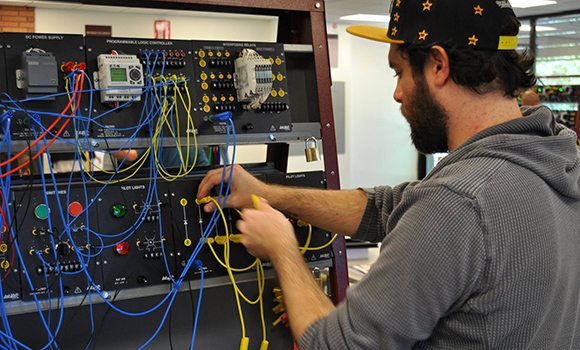
The Industrial Technical Learning Center at Chaffey College in Fontana attracts Inland Empire students looking to enhance their technical skills. (Photo Credit: InTech)
A group of Inland Empire employers met Tuesday and were asked, “How many of you have had a technical skills opening for the last three months?”
Every hand in the room went up.
Those employers who are in need of maintenance technicians and mechanics and electrical technicians and electricians were of one mind. The skills gap is real.
The meeting was held to promote a new paid internship program at Chaffey College’s Industrial Technical Learning Center, or InTech, in Fontana.
Funded by a grant from the James Irvine Foundation, the program will pay 60 interns over the next two years. Employers would bear none of the costs—and each intern will make $15 per hour for up to 400 hours of work. Thus far, 11 of the internships are filled.
“We have openings for cablers and electricians now,” said Abel Munoz, vice president of operations for Foddrill Construction, a Chino company that installs and fixes street lighting in California municipalities. “Intern programs like these can help us and other employers.”
Debbie Smith, chair of the Manufacturers' Council of the Inland Empire, told the audience that it’s not only a skills gap where the labor pool of skilled employers is lacking, but there’s an experience gap.
“If a person has the skills but no experience, he or she might have a hard time finding a job,” said Smith. “We need to get people both skills and experience.”
The program participants will be trained at the Intech Center before they enter a company as interns.
This program is one of many across California that is designed to address the workforce skills gap. The most ambitious is the California Community Colleges Strong Workforce Program, which is implementing a $200-million career technical education investment across the state. More than 700 programs at the local and regional level have been certified with employer input and participation.
“The best candidate for a job is one with formal training paired with work experience,” said Van Ton-Quinlivan, California Community Colleges' vice chancellor for workforce and economic development. “We invite employers to work with our colleges to create internships opportunities. We all need to co-invest in a strong workforce.”
For major regional employers like California Steel Industries, the payoff in internship programs is not only a trained employee, but also one who will stay for a while.
Rod Hoover, CSI’s human resources manager, approached Chaffey College four years ago to develop three-month summer internship programs. As a result, eight of every 10 interns turned into permanent employees after deciding to stay at CSI.
It was that program which really was the inspiration for the Irvine grant.
One of Hoover’s colleagues who accompanied him to the meeting in Fontana was Mario Campa, who tells the students of the great potential of growing with a company. He said that an additional ten interns in either the electrical or mechanical disciplines will be hired because of this program.
For the California Economic Summit, which has been promoting more and smarter investments in California’s workforce preparation for six years, the workforce issue is seminal. If California is going to address the big issues in the state and address the economic insecurity that plagues millions of Californians, more of them must be trained for the 21st-century economy.
As Jim Mayer and Bill Mueller wrote late last year, “To restore upward mobility, California needs one million more graduates with bachelor degrees and one million more workers with middle-skilled credentials over the next 10 years. The Summit led a coalition that supported the creation of a new $200 million Strong Workforce Program for promoting career technical education.”
The community colleges—like Chaffey College in Fontana—play a critical role in working with employers to make sure that investment is working well.

